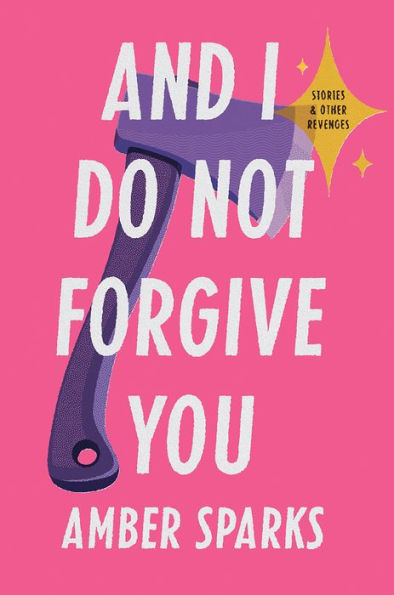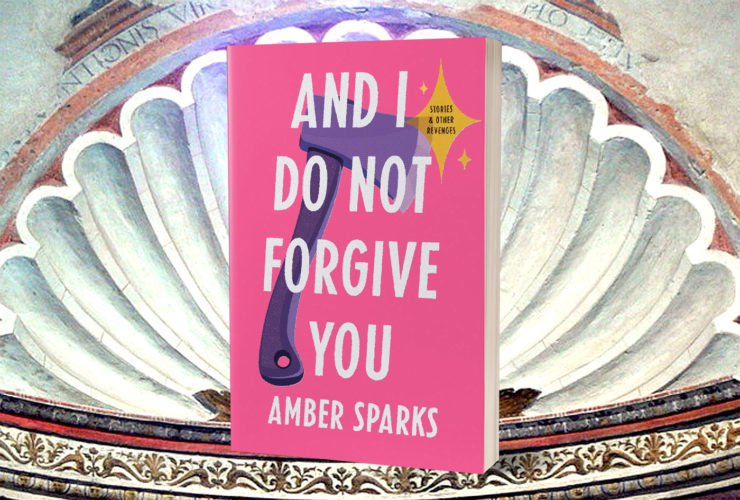Amber Sparks’s previous collection, The Unfinished World, was one of my favorites of 2016. (You can read my review of it here!) So naturally I was excited when her follow-up, And I Do Not Forgive You, landed on my desk. I’m happy to report that I was correct to be excited: this collection is wild ride through rage and gender upheaval and death and ghosts and fairy tale tropes that constantly slalomed around my expectations.
Once again Sparks proves that a short story collection can be even more rewarding than a novel, since you can really dig into a theme or a tone by exploring it through a variety of characters. On the surface, the haunted teen at the center of “Everyone’s a winner in meadow park” doesn’t have too much in common with the refugee fairy tale queen of “Is the Future a Nice Place for Girls”, but they’re both asking the same question, and dealing with the kind of unfocused male rage and unchecked capitalism that leaves a trail of bodies behind it. By taking the fairy tales that are fed to girls from birth and dissecting them and refashioning them into proper bildungsroman, she shows that everyone has a right to their own story, not just the stereotypes and expectations that others place on them.
The book’s tagline “Stories & Other Revenges” sums the contents up neatly: Sparks is here to tell us stories, yes, but she’s also written this book to be a reckoning. Nearly every story mixes mythic storytelling with modern pop culture riffs, internet slang, and hashtags galore. This leads to a very specific type of high wire tone that could very easily go wrong—as much as I reject the idea the brand names and sitcom titles “date” stories, there is a risk that something as ephemeral as memes could seem out of touch, or at least undercut a story’s intensity with a cheap gag. Instead I think it creates the opposite effect, where the darkness at the heart of most of these stories becomes even starker when paired with our magpie internet-addled society.
Buy the Book


And I Do Not Forgive You
My favorite example comes in “We Destroy the Moon”, Sparks gives us a fragmented account of an endtimes cult—the endtimes in question is our own, as the story seems to be set in a Northeastern city just a few years from now, when the weather has gone even weirder and the bees have disappeared, bringing on the gradual collapse of all flora and fauna. People eat fake meat and try to go one with their lives, knowing that everything is falling apart, but completely unequipped to turn the tide. In the midst of this, the main character’s husband goes mad and starts a cult that, depending on his whim, is either a sort of patriarchal resurrection-promising cult, or a fertility cult. Naturally he uses social media to his advantage, whips up a bunch of popular support, crowdfunds a temple:
You insisted that the temple be dressed in blue: priests’ robes dyed indigo aqua for the eyes of the goddess figures set into nooks along the narrow passageways. You said the ancient Egyptians called blue the color of heaven. You said it looked great in pictures. #lapislazuli.
I wish I could say that, when the time comes, humanity won’t hashtag our own ending? But as a person who pretty much lives online now, this felt #tooreal.
Many of the main characters are artists. This is very much a book of what I would call out post-Nanette world—many of the women and AFABs are artists, beset on all sides by the forces of capitalism and patriarchy that want to oppress them, destroy their work, or simply take up so much of their time that they can’t get anything done. This becomes a leitmotif of the book, as we watch these characters claw their way through artistic careers, knowing that they’re not learning anything useful from their struggles, they’re not being made better artists by their struggles—they’re simply something they have to get through to get to their work.
“We Destroy the Moon”’s main character is a sculptor who gives up her work under the combined pressures of a disturbed husband and the collapse of Western Civilization. These two things become entwined when the husband starts an endtimes cult. At first, he wants to commission work from her, mighty statues to decorate his temple. Later things go wrong and he starts trying to control her behavior in the ways typical of cults run by men.
“Athena Designs a Videogame with the sole Purpose of Trolling her Father” does what it says on the tin, but marks out the perfect detail of Athena, the favorite, coming right up to the edge of mocking her father to his face, but dancing back from that edge since he’s still, after all, the God of All Gods. He can crush her if he wants to. He can transform her into a new form, and she’ll have no choice but to live life as a swan or an earthworm or a tree. And she can be disgusted when he tells her to make sure her videogame designs include nymphs with “big tits” for “fanservice”—but she still lives in a universe that bends itself to his whims. Her subversive art, while brave, will not effect any real change.
I would be remiss if I didn’t also mention that Sparks’ language is thrilling. Describing a stale marriage:
The wife thought the husband lacked spirit. He would hunch silent over his breakfast in the mornings, hands pale and cold as his cereal, his hair the color of cubicles. The married becuase the wife thought should could open him up, pull out the wild Irish weather. But when she tried she found a map of Cleveland instead. Her days grew long and endless as parades.
I mean. “Hair the color of cubicles”? A flat and depressed life likened to the forced jollity of a parade? Or how about:
Stop talking about death, people always say. As if it were taboo. As if it weren’t the Great Leveler. I was trained up to a life of accountancy and account-settling, so how can I not include it in my calculations? WHO DOESN’T LIE AWAKE AT NIGHT AND THINK ABOUT DEATH? I don’t believe it. Death deserves all caps. To deny it is like denying that you eat sandwiches. Everyone eats death.
Sparks is a master at inventive retellings of fairy tales and in this collection she takes on an especially dark one, “Donkeyskin.” A young princess is enjoying her privileged life, learning to paint and hanging out with her fairy godmother, when her father notices she’s gorgeous and tries to, uhh, marry her. The middle section of the story runs through the tricks the princess and the Fairy Godmother pull on the King by demanding wedding gifts in the form of dresses that will be impossible for his seamstresses. Of course, the challenges are defeated. After the Princess asks for a dress the exact color of bone:
As she’s dreaded, the dress is the color of bone, a dingy yellow-white shot through with streaks of pink. She models it for the king-her-father and he closes. his eyes in pain I can’t think, he says, why you would want such a thing; it’s as though you’ve turned yourself inside out.
Sparks creates an incredible balance between the dark comedy of the Godmother’s machinations and the grotesque situation that has trapped the Princess is in. But that isn’t the important part of the story. The important part is that this princess is an artist who spends years honing her craft, and has real aspirations for her work. The point of the story is not what her father tries to do to her, or what any of the other men in the story try to do to her—the point is that her life is shaped by her decision to create art.
And then there’s “You Won’t Believe What Really Happened to the Sabine Women.” This is the kind of story I love. In the parlance of our milliseconds, I think it’s still safe to call this story Extremely My Shit, in fact, but that’s part of the point. There were a few months, in around 2015, when every third article on the internet was titled some variation on “You Won’t Believe What Happened to the Lead Singer of Smashmouth” or “You Won’t Believe The Real Reason No One Hires Kirk Cameron Anymore” or whatever and then, like all things internet, the trend was overused, flared up, imploded, and soon the construction was only used to mock the kinds of articles that would do it sincerely. By combining this title structure with a particular moment from mythology/art history Sparks is able to destabilize us going in. Then she teases out the story of the Sabine Women themselves, and the weird experience of studying mythology or art as a woman or woman-adjacent person, when you’re presented with this tale of rape and then reassured that the survivors stayed with their attackers. When you see terrified women being swept up onto rampaging horses and you’re just expected to study it with no emotional connection. When this terrible story is dissected and painted and the idea that a rape survivor—of any gender—might have to look at it, might have to process it.
Sparks creates an ironic distance, she creates a gap between our amusement at the title and our knowledge of the Sabine Women, but of course she’s just telling us “what really happened to them”. which is that they were attacked and terrorized and tortured, and that their stories were simply folded into a larger myth, and their story was retold by men in a way that made them almost complicit in their own assaults.
You know, the thing that “really happens” to a lot of survivors.
Several of the shorter stories are really transmogrifications: the story of an overlooked woman turns into a superhero arc; a transgirl’s coming-of-age is told in fairy tale terms; a person sprouts wings–but the wings aren’t the point of the story, rather it’s the creativity to use them. These tiny, potent flash fictions will stick in your brain for days. But Sparks is just as adept at relaxing into the longer stories, unspooling a coming-of-age/ghost story that spans years and tackles class issues and misogyny through the friendship of two girls as they move through adolescence. And then there’s the one that might be my favorite, A Short and Slightly Speculative History of Lavoisier’s Wife, which takes the story of Lavoisier’s life, chemistry experiments, and eventual execution during the French Revolution, and refocuses it to look at how his wife acted as his lab assistant, translator, and record-keeper. The only truly “speculative” part of the story is the language, which updates Mme Lavoisier’s speech to reflect a slightly more Millennial sensibility, but otherwise the story just shows us that this child bride, married off at the age of 13, widowed during a revolution, and remarried to a man who hated hearing about her first husband, probably would have been a great thinker in her own right given a reasonable society.
As this collection points out again and again, we don’t live in a reasonable society, but Sparks is doing her best to make sure at least some of the women of our history have their revenge.
And I Do Not Forgive You is available from Liveright Publishing.
Background image “Cathedral (Aosta) Fresco” by Wolfgang Sauber used and altered under the Creative Commons Attribution-Share Alike 3.0 Unported










